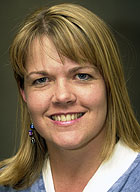Autism researchers at the School of Medicine are joining other scientists to image the brains of infants and attempt to identify anatomical and behavioral changes that may be linked to the onset of autism.

Botteron
The $10 million Infant Brain Imaging Study funded by the National Institutes of Health allows investigators to analyze early brain development in children at risk for autism spectrum disorders by virtue of having an autistic sibling.
The study builds on two key findings. The first is that children with autism tend to have larger brains — between 5 percent and 10 percent larger by age 2 — than children who don’t have the disorder. Data from pediatricians measuring head circumference suggests the enlargement could begin at the end of a child’s first year of life. The second finding suggests the onset of social deficits associated with autism usually cannot be detected until the end of the first year.
“We don’t know much about brain development in children with autism or children at risk for autism, but we do know that symptoms start very early,” said Kelly N. Botteron, M.D., principal investigator at the WUSTL study site and an associate professor of child psychiatry and of radiology. “We think it’s going to be very important to learn about the changes in early brain development that may be associated with autism.”
Botteron’s team is joining researchers from the University of North Carolina, the University of Washington in Seattle and Children’s Hospital of Philadelphia, collecting MRI brain images from children as young as 6 months old. The project also includes a data-coordinating center at the Montreal Neuro-logical Institute in Canada.
“We’re recruiting infants as young as possible — even during the mother’s pregnancy — for interviews and screenings, and then they come to see us for brief testing and to have MRI scans at 6 months,” said Botteron, a child psychiatrist at St. Louis Children’s Hospital. “They come back for more scans and more testing at 12 months and again at 24 months.”
The WUSTL portion of the Infant Brain Imaging Study uses MRI imaging to get a very detailed look at the brain’s anatomy. The investigators also perform what’s called resting-state, functional MRI imaging, which provides information about how the various structures in the brain connect to one another while the baby is resting. A third imaging technique, called diffusion tensor imaging, allows Botteron’s team to analyze characteristics of the brain’s gray matter and white matter.
The imaging is done in the evening while the babies are asleep.
“The parents rock the baby to sleep, and we put headphones over their ears so the noise of the MRI machine won’t wake them up,” Botteron said. “Most of the infants we’ve studied so far have slept peacefully for the 45 minutes or so that it takes to complete the various scans.”
The brain scans in the study are noninvasive. There are no needle sticks or contrast dyes to ingest. Babies are monitored closely throughout their scans, and if a child starts to wake up or cry, that baby is taken out of the scanner immediately.
Botteron plans to collect brain images from 110 infants with an autistic sibling. She also will scan the brains of 60 control infants who don’t have a sibling with autism. Families who participate in the study are compensated for time and travel.
The five-year study will allow researchers to follow the infants over time to identify which infants develop autism and whether the brain scans can help predict that risk.
“The vast majority of infants enrolled in the study will not develop autism,” Botteron said. “However, siblings of children with autism do have a higher risk of the disorder, so we expect between 10 percent and 15 percent of the infants in the study will develop noticeable and detectable symptoms by the age of 2.”
For more information about the study, contact Lisa Flake at flakel@psychiatry.wustl.edu or visit infantsibs-stlouis.org/index.php.